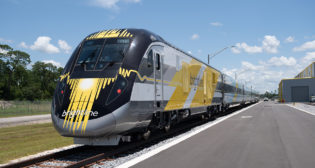
An RRIF-centered capitalization growth strategy
Written by AdministratorThe RRIF program was conceived to support more direct, local rail service. But such service may be in retreat.
The FRA’s Railroad Rehabilitation and Improvement Financing (RRIF) program is authorized to lend $35 billion, an amount equal to the fourth largest hedge fund in the world. Imagine the opportunity if this “hedge fund” pledged 100% of its capital to the U.S. rail industry, and in return demanded no equity, no control, and no decision-making power. Better still if there were 35 years to repay at the same interest rate enjoyed by the federal government, and payments could be deferred for up to five years.
That, in essence, is what RRIF offers, but since the RRIF program began in 2000, only 2% of the funding has been utilized while 7,000 miles of a 147,000-mile rail system have been abandoned. Is there a direct connection? No, but there is a missed connection.
The RRIF program was conceived to support more direct, local rail service, particularly by the branch line network. But across the country, from the Philadelphia metro area to southeast Arkansas to the Wasatch Front to California, direct rail service may be in retreat. Closing more RRIF loans without confronting a shrinking rail network will doom the country to higher transportation costs, as more of rural and urban America invests in economic revitalization without the benefit of local rail service.
Highway congestion, air quality concerns, and increasing mining for natural resources all point to the urgent need for expanding direct rail service, not just high-volume corridors and terminals. Surging demand for freight rail transportation has yet to be met with a comprehensive plan for growing rail service.
RRIF loans can transform the financial prospects of individual borrowers, and the industry as a whole, if conceived within this long-range plan for growth. When the collateral agreements, terms, and timing are engineered thoughtfully, RRIF loans can seed a significant increase in overall capitalization. The RRIF program, however, continues to be treated as a “lender of last resort” rather than the catalyst for a rebuilding boom.
The RRIF program as it always has been is available but challenging. That should improve this year as the House Railroad Subcommittee and the FRA take steps to streamline the process. But more than anything, what’s needed is an alignment among stakeholders around an industry-wide growth plan developed and implemented by the public and private sectors working in concert, not opposition.
Our usual methods of stakeholder interaction often deliver public-sector programs like RRIF that miss the opportunity to stimulate desired results in the private sector. Government personnel appeal to lobbyists and association representatives to gain from their industry knowledge of rail financing issues. Usually, however, these industry representatives are focused on more government funding, not seeding private-sector capitalization.
For instance, funding was inserted in FY ’00 by then-Chairman Frank Wolf (R-Va.) of the House Transportation Appropriations Subcommittee for a credit tools project Strategic Rail Finance designed that would have lowered RRIF credit risk premiums while providing banks with data to increase lending to Class II and III railroads. Industry lobbyists squashed this effort to perpetuate the case for RRIF as the only funding solution.
Urgent environmental and economic crises demand that we embrace new ideas and stop blaming the FRA, OMB, DOT, the Administration, Congress, or the applicants for the limited success of the RRIF program. Intelligent cooperation can leverage the $35 billion RRIF loan pool into billions more in private capitalization if we replace antipathy with a willingness to collaborate.
We are working with stakeholders to create new mechanisms for states to participate in an increased flow of RRIF loans. Most states are anxious to encourage rail service but have limited funding available to invest directly. The possibilities for stimulating more RRIF loans include state loan guarantees, pledges of state-owned rail assets, and subsidies for application costs and credit risk premiums. The RRIF program also has a loan guarantee function that can be utilized to encourage local bank lending for rail projects.
When we coordinated the largest RRIF loan to a Class III railroad in the history of the program it wasn’t just the RRIF funding that mattered. It was the millions of dollars in new private-sector capital that resulted from our creative structuring. This approach can be institutionalized to benefit all RRIF borrowers and the whole country as we look to capitalize rail development with limited public sector funds.
Bridging this performance gap is within our reach. We can accomplish much more than simply more RRIF loans. The real opportunity is to place RRIF loans at the center of an intelligent rail growth capitalization strategy.
Michael Sussman is President of Strategic Rail Finance. a financial services and business advisory firm.



